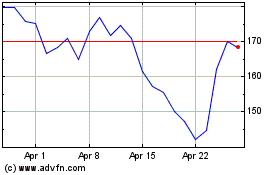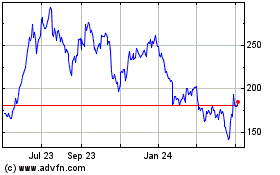By Jason Zweig
Back in Business is a new, occasional column that puts the
present day in perspective by looking at business history and those
who shaped it. Read the first installment here. Mr. Zweig's
Intelligent Investor column will return next week.
A hot stock doubles and then doubles again in a matter of weeks.
Thousands of people who have never invested in their lives suddenly
try to beat the market.
That isn't just a description of Tesla Inc. and day-trading
customers of the Robinhood smartphone app in 2020. It's also what
happened in 1720. Three hundred years ago, one of the biggest
manias in financial history was at its peak.
In the summer of 1720, shares in the South Sea Co. and other
leading stocks roared to all-time highs as speculators chased
instant profits. Ever since, this sudden outbreak of stock trading
has been known as " the South Sea bubble." Even faster than it
inflated, it burst -- and left us with lessons about human nature
that reverberate today.
From July 10 through July 12, 1720, South Sea shares perched at
GBP950, up 650% for the year. Royal Exchange Assurance and London
Assurance crested in late August, up an astonishing 1,243% and
4,220% for the year, respectively.
Then, in three catastrophic weeks in September, it all began
crashing down. By the end of 1720, these leading stocks had fallen
between 81% and 96% from their peak.
The losses were devastating because speculating had been so
popular.
King George I, half the members of Parliament, Sir Isaac Newton,
the poet Alexander Pope, and countless merchants and tradesmen had
speculated on the South Sea and other companies.
They all were sucked in by a perfect magnetic storm: the rapid
advent of newspapers, ready loans at low interest rates, and
exciting narratives about technological innovation. Above all was
the eternal human desire to be part of the in crowd, or what we
today would call FOMO, fear of missing out. "Our species is really
a herd animal," says Andrew Odlyzko, a mathematician at the
University of Minnesota who researches financial bubbles.
Bubbles are as old as financial markets. Even in ancient
Babylon, commodity prices took sudden leaps and falls that can't be
fully explained by weather or war.
In 1720, "the scent of money was in the air like the breath of
spring," as the historian John Carswell put it. That June alone, 88
startups, most of them publicly traded, were launched in London.
Many sought to raise GBP1,000,000 to GBP5,000,000 apiece (roughly
$190 million to $945 million in today's money), tapping into what
Daniel Defoe, author of "Robinson Crusoe," called " the general
projecting humor of the nation."
A London housekeeper reportedly racked up GBP8,000 in gains, at
least $1.5 million in today's money. Fistfights broke out over the
right to buy stock while it still could be had; speculators
thronged London's financial district to buy shares in any company,
desperately pleading, " we don't care what it is."
Financial bubbles are often cited as proof of irrationality, but
what they prove is that investors are human. As one formerly
cautious banker, throwing some of his own money into the South Sea,
pointed out on June 18, 1720: "When the rest of the world is mad we
must imitate them in some measure."
New media technologies -- newspapers in 1720, radio in the
1920s, the internet in the 1990s, social media and smartphone apps
today -- are "the cultural substrate in which a mania can grow,"
says William Deringer, a financial historian at the Massachusetts
Institute of Technology.
As word spreads that "everybody" is doing something, it can be
hard for anybody to resist joining. Humans have a profound need to
belong to a group. Investing in something popular makes us feel
popular.
In 18th-century London, coffee houses and ballrooms became
centers of market gossip. One woman wrote: "South Sea is all the
talk and fashion. The ladies sell their jewels to buy, and happy
are they that are in... Never was such a time to get money as
now."
Two centuries later, the financial analyst Benjamin Graham wrote
about the bull market that ended in the crash of 1929: "Countless
people asked themselves, 'Why work for a living when a fortune can
be made in Wall Street without working?'" Graham added wryly, "The
ensuing migration from business into the financial district
resembled the famous gold rush to the Klondike, with the not
unimportant difference that there really was gold in the
Klondike."
Today, the online platform Reddit teems with speculators
boasting about their biggest trades.
Imitation isn't always irrational, either. It helped our
ancestors save mental and physical labor and adapt more quickly to
changing environments, says William Bernstein, a neurologist and
author of the forthcoming book "The Delusions of Crowds." Seeing
many others invest in something sends a powerful, if often
inaccurate, signal that it might be a good idea.
That can quickly coalesce into a narrative, in which our
imaginations rapidly transport us to different places and times.
("I'll become rich, just like they did.") A good story, as the poet
Samuel Taylor Coleridge wrote, automatically triggers a " willing
suspension of disbelief for the moment."
The South Sea bubble brimmed with "story stocks." Among them
were firms claiming they would "trade in hair," import " a number
of large jack-asses from Spain," develop an " air pump for the
brain," convert sewage into gunpowder and even conduct an
unspecified business that would somehow "turn to the advantage" of
its investors.The South Sea Co. had its own story: Originally
created to sell enslaved people to Spain's American colonies, by
1720 it had morphed into a complex scheme for refinancing the
British government's massive war debts. Attracting investments from
the British public was key to making the scheme work -- or at least
appear to work. (In the end it failed, casting a pall over the
British economy for years to come.)
Investors today are barely wiser. Only last year, private funds
valued WeWork, the office-sharing company that claimed it would "
elevate the world's consciousness," at $47 billion. It was later
marked down by roughly 80%.
The South Sea bubble did have many critics at the time. But
conformity is a powerful force that can counteract gravity for
longer than skeptics often expect. Bubbles are neither rational nor
irrational; they are profoundly human, and they will always be with
us.
Write to Jason Zweig at intelligentinvestor@wsj.com
(END) Dow Jones Newswires
July 17, 2020 10:15 ET (14:15 GMT)
Copyright (c) 2020 Dow Jones & Company, Inc.
Tesla (NASDAQ:TSLA)
Historical Stock Chart
From Mar 2024 to Apr 2024

Tesla (NASDAQ:TSLA)
Historical Stock Chart
From Apr 2023 to Apr 2024
